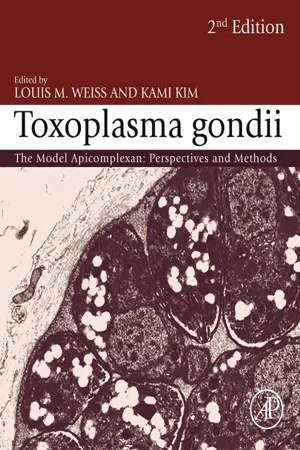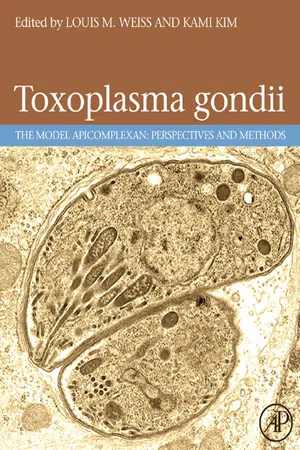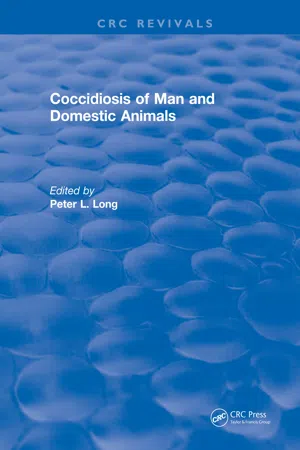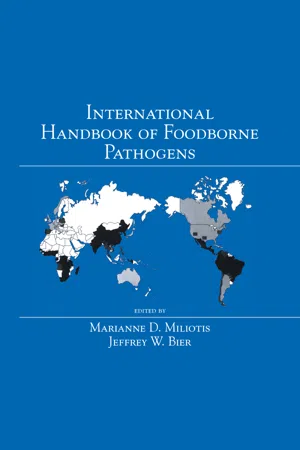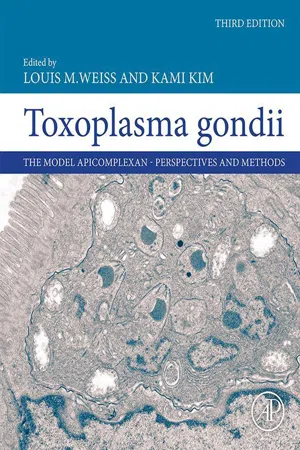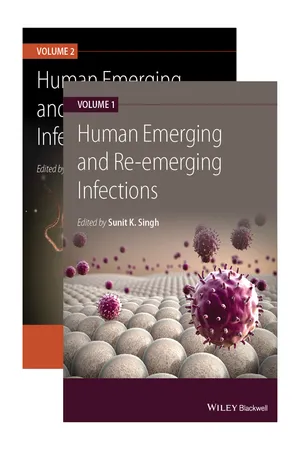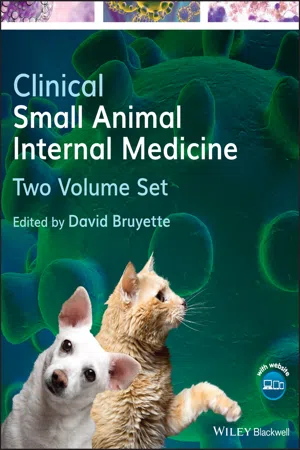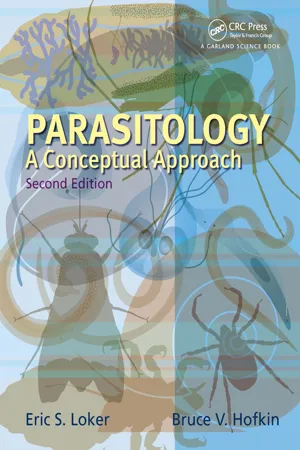Biological Sciences
Toxoplasma Gondii Life Cycle
Toxoplasma gondii is a parasite with a complex life cycle. It can infect a wide range of warm-blooded animals, including humans. The parasite's life cycle involves sexual reproduction in the intestines of cats, with the oocysts being shed in the cat's feces and then spreading to other animals through ingestion.
Written by Perlego with AI-assistance
9 Key excerpts on "Toxoplasma Gondii Life Cycle"
- eBook - ePub
Toxoplasma Gondii
The Model Apicomplexan - Perspectives and Methods
- Louis M. Weiss(Author)
- 2013(Publication Date)
- Academic Press(Publisher)
Chapter 1The History and Life Cycle of Toxoplasma gondii
Jitender P. Dubey, Animal Parasitic Diseases Laboratory, Beltsville Agricultural Research Center, Agricultural Research Service, United States Department of Agriculture, Beltsville, Maryland, USAAbstract
Toxoplasma gondii has a complex life cycle with multiple forms. Intermediate hosts such as humans are infected by sporozoites in oocysts or bradyzoites in pseudocysts whereas the sexual stages occur in the intestine of the definitive host, feline species. The parasite is unusual in that it does not need to pass through sexual stages or its definitive host for transmission to other species. This chapter summarizes the history of the discovery of the parasite, identification of the definitive host and transmission stages of the parasite, as well as other important discoveries in the basic biology and life cycle of T. gondii . This chapter also provides photomicrographs of the life cycle stages of this organism.OutlineKeywords
tachyzoite; bradyzoite; sporozoite; sexual cycle; transmission; toxoplasmosis; diagnosis1.1 Introduction 1.2 The Etiological Agent 1.3 Parasite Morphology and Life Cycle 1.3.1 Tachyzoites 1.3.2 Bradyzoite and Tissue Cysts 1.3.3 Enteroepithelial Asexual and Sexual Stages 1.4 Transmission 1.4.1 Congenital 1.4.2 Carnivorism 1.4.3 Faecal–Oral 1.5 Toxoplasmosis in Humans 1.5.1 Congenital Toxoplasmosis 1.5.2 Acquired Toxoplasmosis 1.5.2.1 Children 1.5.2.2 Toxoplasmosis in Adults 1.6 Toxoplasmosis in Other Animals 1.7 Diagnosis 1.7.1 Sabin–Feldman Dye Test 1.7.2 Detection of IgM Antibodies 1.7.3 Direct Agglutination Test1.7.4 Detection of T. gondii DNA1.8 Treatment 1.9 Prevention and Control 1.9.1 Serologic Screening During Pregnancy 1.9.2 Hygiene Measures 1.9.3 Animal Production Practices 1.9.4 Vaccination Acknowledgements ReferencesAcknowledgements
I would like to thank Drs. Georges Desmonts (now deceased), David Ferguson, Jack Frenkel, H.R. Gamble, Garry Holland, Jeff Jones, and Jack Remington for their helpful discussions in the preparation of this manuscript. - eBook - ePub
- Felipe Kierzenbaum(Author)
- 2013(Publication Date)
- Academic Press(Publisher)
6Toxoplasmosis
Françoise Darcy and Ferrucio SantoroPublisher Summary
This chapter discusses toxoplasmosis, which is an infection of worldwide distribution affecting almost all warm-blooded animal species. In intermediate hosts, such as birds and mammals, including humans, T. gondii undergoes asexual multiplication with two parasite stages: (1) the tachyzoite, which is the intracellular proliferative form present during the acute phase of infection, and (2) the bradyzoite, which is the slowly dividing encysted form characteristic of the chronic phase of toxoplasmosis. Bradyzoites persist for the lifetime of the host. In humans, T. gondii is generally acquired by the oral route, after ingestion of raw or undercooked meat containing parasite cysts, vegetables, or water contaminated by oocysts from infected cat feces. Another way of transmission is the transplacental passage of parasites from infected mothers to fetuses. When orally ingested, the bradyzoites or sporozoites enter enteroepithelial cells where they give rise to tachyzoites within a few hours. The tachyzoites are capable of infecting all cell types and quickly divide by endodyogeny. This chapter discusses the distinctions that have been made between toxoplasmosis acquired by the oral route and congenital toxoplasmosis, in which fetal infection is parenteral via the umbilical vein from the placenta.I Toxoplasma gondii Life Cycle
Toxoplasmosis is an infection of worldwide distribution affecting almost all warm-blooded animal species (reviewed by Dubey and Beattie, 1988 ). Toxoplasma gondii, the causative agent, is an intracellular coccidian parasite discovered in 1908 simultaneously at the Tunis Pasteur Institute in the wild rodent Ctenodactylus gondi (Nicolle and Manceaux, 1908 ) and in Brazil in a laboratory rabbit (Splendore, 1908 ). Although T. gondii is an important pathogen for humans, it was not until 1923 that it was isolated at autopsy from the retina of a child (Janku, 1923 ). The high incidence of human toxoplasmosis could be established only after the development of a reliable test (Sabin and Feldman, 1948 - eBook - ePub
Toxoplasma Gondii
The Model Apicomplexan. Perspectives and Methods
- Louis M. Weiss, Kami Kim(Authors)
- 2011(Publication Date)
- Academic Press(Publisher)
1The History and Life Cycle of Toxoplasma gondii
J.P. DubeyPublisher Summary
Infections by the protozoan parasite Toxoplasma gondii are widely prevalent in humans and other animals on all continents. This chapter provides a history of the milestones in the acquisition of knowledge of the biology of this parasite. Toxoplasmosis in sheep deserves special attention because of its economic impact. The identification of T. gondii abortion in ewes is considered a landmark discovery in veterinary medicine; prior to that, protozoa were not recognized as a cause of epidemic abortion in livestock. The ability to identify T. gondii infections based on a simple serological test opened the door for extensive epidemiological studies on the incidence of infection. It became clear that T. gondii infections are widely prevalent in humans in many countries. It also demonstrated that the so-called tetrad of clinical signs considered indicative of clinical congenital toxoplasmosis occurred in other diseases and assisted in the differential diagnosis. Vaccination of sheep with a live cystless strain of T. gondii reduces neonatal mortality in lambs, and the vaccine is available commercially.1.1. Introduction1.2. The etiological agent1.3. Parasite morphology and life cycle1.4. Transmission1.5. Toxoplasmosis in humans1.6. Toxoplasmosis in other animals1.7. Diagnosis1.8. Treatment1.9. Prevention and controlAcknowledgements References1.1 INTRODUCTION
Infections by the protozoan parasite Toxoplasma gondii - eBook - ePub
- Peter L. Long(Author)
- 2019(Publication Date)
- CRC Press(Publisher)
T. gondii and toxoplasmosis is likely to proceed.II Life Cycle
Although the parasite was first identified and named in 1908,3 it was not until 1970 that its full life cycle was completed.4 -8 The main stages and routes of transmission in the life cycle of T. gondii are outlined in Figure 1 . The life cycle can be divided into five main stages: schizogony, gametogony, oocyst formation, the tachyzoite, and the bradyzoite (tissue cyst stage).Schizogony is an asexual multiplication stage which occurs only in Felidae,9 ,10 Ingestion of tissue cysts initiates the process which occurs in the intestinal epithelium.4 -8Bradyzoites, the resting stage of the parasite present in tissue cysts, are relatively resistant to digestive juices although the cyst wall is destroyed immediately.11 After bradyzoites enter the feline intestinal cells they undergo several development stages designated “Types” A—E. Knowledge on the development of merozoite types occurring during schizogony was elucidated by Dubey and Frenkel12 and Dubey.13Gametocytes occur in the surface epithelium of the entire length of the small intestine, but more commonly in the ileum. They can be seen from 3 to 15 days after tissue cyst ingestion. Fusion of a male and female gamete leads to oocyst formation which is then detached from the intestinal epithelium and discharged. Oocyst formation occurs from 3 to 5 days after tissue cyst ingestion.14The length of time required for sporulation of the oocyst is from 1 to 5 days depending on several environmental factors such as temperature and oxygen tension.14 ,15 The sporulated oocyst contains two sporocysts each containing four sporozoites. The oocyst can survive in an inimical environment under a wide range of adverse conditions. They remain infective for at least 410 days at 4°C but lose their viability after 30 days at 37°C. Unprotected oocysts, kept outside and exposed to direct sunlight, remained infective for 46 days. If the oocysts were covered when kept outdoors they remained infectious for at least 410 days.16 The longevity of the infectious oocyst under conditions similar to those in which cats bury their feces is of major importance in the transmission of toxoplasmosis. Herbivores such as sheep and goats can ingest the oocyst directly and humans may contact the infectious stage while cleaning out cats’ litter bins or when playing in sand pits.17 - eBook - ePub
- Marianne D. Miliotis, Jeffrey W. Bier(Authors)
- 2003(Publication Date)
- CRC Press(Publisher)
30
Toxoplasma gondii
Miles B. MarkusBiomedical Analysis International, London, EnglandI. BACKGROUND
Toxoplasma gondii is a protozoan organism that is currently becoming a popular model for researching cellular, immunological, and molecular aspects of intracellular parasitism. Toxoplasma was first isolated in 1908 from a North African rodent, the gondi—hence the species name. The generic appellation is derived from the Greek word toxon, for bow, which refers to the crescentic shape of tissue zoites of the parasite. Toxoplasma can be harbored by many vertebrates. Most infections in humans are subclinical, but Toxoplasma is an important opportunistic pathogen in persons who are immunocompromised. It can be a particular danger to the fetus. One of the most important sources of human toxoplasmosis is food.II. CHARACTERISTICS
Toxoplasma belongs to the group of protozoan parasites that are classified together as the Sporozoa (synonym: Apicomplexa). As a result of advances in molecular phylogenetics and morphological cladistics, the Sporozoa have recently been placed in a new clade, the Alveolata (1 ).Although the extraintestinal stages of Toxoplasma have been known for almost a century, knowledge of the life cycle was incomplete until nearly 35 years ago, when coccidian asexual (schizogonic) and sexual (gametogonic) stages were seen in the intestinal epithelium of experimental domestic cats. Wild members of the family Felidae can also act as definitive hosts. The sexual cycle results in the formation of oocysts (containing sporozoites), which are shed in the cat's feces, making it easy to understand how many human infections and most of those in noncarnivorous vertebrates are acquired.It is widely assumed that postnatally, humans or animals usually become infected with Toxoplasma by swallowing food or water contaminated with oocysts or by inadvertently eating tissue cysts in uncooked meat or offal (viscera). After ingestion, sporozoites or the organisms from tissue cysts convert to a rapidly multiplying stage that has been given the name tachyzoite (or endozoite). This replication takes place intracellularly by endodyogeny (formation of daughter cells, each surrounded by its own membrane, while still in the mother cell). Toxoplasma reproduces asexually in this way in a wide range of cells in the body. At a later stage of the infection, slowly dividing, encysted bradyzoites (or cystozoites) are characteristically present in muscle and in the central nervous system (2 - eBook - ePub
Toxoplasma Gondii
The Model Apicomplexan - Perspectives and Methods
- Louis M. Weiss, Kami Kim(Authors)
- 2020(Publication Date)
- Academic Press(Publisher)
Chapter 1The history and life cycle of Toxoplasma gondii
J.P. Dubey, Animal Parasitic Diseases Laboratory, United States Department of Agriculture, Agricultural Research Service, Beltsville Agricultural Research Center, Beltsville, MD, United StatesAbstract
Infections by the protozoan parasite Toxoplasma gondii are widely prevalent in humans and other animals on all continents. There are many thousands of references to this parasite in the literature, and it is not possible to give equal treatment to all authors and discoveries. The objective of this chapter is, rather, to provide a history of the milestones in our acquisition of knowledge of the biology of this parasite.Keywords
Toxoplasma gondii ; history; cats; oocyst1.1 Introduction
Infections by the protozoan parasite Toxoplasma gondii are widely prevalent in humans and other animals on all continents. There are many thousands of references to this parasite in the literature, and it is not possible to give equal treatment to all authors and discoveries (Dubey, 2008 ). The objective of this chapter is, rather, to provide a history of the milestones in our acquisition of knowledge of the biology of this parasite.1.2 The etiological agent
Nicolle and Manceaux (1908) found a protozoan in tissues of a hamster-like rodent, the gundi, Ctenodactylus gundi , which was being used for leishmaniasis research in the laboratory of Charles Nicolle at the Pasteur Institute in Tunis. They initially believed the parasite to be Leishmania but soon realized that they had discovered a new organism and named it T. gondii based on the morphology (mod. L. toxo =arc or bow, plasma =life) and the host (Nicolle and Manceaux, 1909 ). Thus its complete designation is T. gondii (Nicolle and Manceaux, 1908 , 1909 ). In retrospect the correct name for the parasite should have been T. gundii , as Nicolle and Manceaux (1908) had incorrectly identified the host as Ctenodactylus gondi . Splendore (1908 , see also English translation Splendore, 2009) discovered the same parasite in a rabbit in Brazil, also erroneously identifying it as Leishmania , but he did not name it. It is a remarkable coincidence that this disease was first recognized in laboratory animals and was first thought to be Leishmania - eBook - ePub
- Sunit Kumar Singh, Sunit Kumar Singh(Authors)
- 2015(Publication Date)
- Wiley-Blackwell(Publisher)
Primary T. gondii infection in immunocompetent patients is mostly asymptomatic but in immunocompromised individuals it may cause life-threatening encephalitis, while infection during pregnancy can lead to various diseases for the fetus and the newborn infant. The parasite is able to maintain its life cycle for many generations in the absence of cats and the oocyst stage due to carnivorism and in some host species, like mice, repeated transplacental transmission of the infection. 16.2.1.4 Cats and the oocyst cycle When cats ingest oocysts, very few will shed them. The few cats that do shed oocysts will have a long pre-patent period of almost 3 weeks, rather than the normal pre-patent period of about 3 days, when tissue cysts are ingested (Dubey, 2010). This is because only bradyzoites can make schizonts in the cat's enterocytes. Toxoplasma gondii sporozoites excyst in the cat's intestine and penetrate the lamina propria. They stage convert to tachyzoites and multiply. Eventually the tachyzoites stage convert to bradyzoites. These bradyzoites then must enter epithelial cells and stage convert to schizonts. This developmental cycle is the reason for the observed long pre-patent period and for the relatively few cats that excrete oocysts after ingesting oocysts. For these reasons, T. gondii is able to have two distinct life cycles, one using an intermediate host and the other using only felines (Figure 16.1). 16.3 Transmission 16.3.1 Foodborne transmission Toxoplasma gondii tissue cysts (Figure 16.4) survive for the life of the host and are present in most edible tissues. People can become infected orally by (i) ingestion of raw or undercooked infected meat (such as pork, goat, lamb, and wild game); (ii) by accidental ingestion of tissue cysts after handling infected meat; (iii) eating food contaminated by knives, cutting boards, or other utensils that have had contact with raw, infected meat; and (iv) rarely by drinking non-pasteurized goat's milk - eBook - ePub
- David Bruyette, David Bruyette(Authors)
- 2020(Publication Date)
- Wiley-Blackwell(Publisher)
110 Protozoal and Protozoa‐Like Infections Gad Baneth, DVM, PhD, DECVCP1 and Laia Solano‐Gallego, DVM, PhD, DECVCP2 1 School of Veterinary Medicine, Hebrew University, Rehovot, Israel 2 Facultat de Veterinaria, Universitat Autonoma de Barcelona, Barcelona, SpainParasites are responsible for some of the most important and widespread diseases of domestic dogs and cats. Some of these parasitic infections are also zoonotic and can infect humans. A thorough understanding of the pathogenesis and epidemiology of these parasitic diseases is required in order to treat infected pets and prevent the spread of disease efficiently. This chapter focuses on important protozoal diseases in dogs and cats with emphasis on etiology, pathophysiology, clinical manifestations, diagnosis, treatment, and prevention.Toxoplasmosis
Etiology and Pathophysiology
Toxoplasma gondii is a tissue coccidian protozoon with a sexual life cycle in the intestine of felids, the definitive host, and an asexual phase in intermediate hosts. The intermediate hosts of T. gondii include all warm‐blooded vertebrates including humans. Cats and intermediate hosts can be infected by bradyzoites in meat or by sporulated T. gondii oocysts from cat feces. Cats shed T. gondii oocysts in their feces within 3–10 days after infection by bradyzoites from tissue cysts and excretion continues for approximately 7–21 days (median eight days) with massive shedding which can reach hundreds of millions of oocysts per cat during the shedding period. After that initial period, risk of further oocyst shedding is limited. Oocysts in cat feces undergo sporulation in the environment and develop sporocysts containing infective sporozoites within 1–5 days in appropriate humidity, temperature, and oxygenation conditions [1 ].After oral infection, T. gondii - eBook - ePub
Parasitology
A Conceptual Approach
- Eric S. Loker, Bruce V. Hofkin(Authors)
- 2022(Publication Date)
- CRC Press(Publisher)
Asexual reproduction, usually via binary fission, is a common feature of the parasitic protozoan life cycle. Entamoeba histolytica, for instance, is the primary agent responsible for amebic dysentery in humans. This strictly human parasite has a direct life cycle. Transmission is via the fecal–oral route. The infective stage (the cyst) contains four trophozoites formed by two rounds of cell division. Following ingestion, the cyst passes through the stomach to the lower portion of the small intestine where excystation and trophozoite release occurs. These trophozoites migrate to the large intestine where they feed on cellular debris and bacteria and undergo multiple rounds of binary fission. Under certain conditions, many of which remain to be characterized, trophozoites encyst and are released with the feces. Kinetoplastids are flagellated protozoa, which include among their ranks some of the most important human and animal parasites. Trypanosomes are responsible for both human and animal trypanosomiasis, whereas Leishmania spp. cause either cutaneous or visceral leishmaniasis. These parasites have indirect life cycles and use vector transmission. In all of them, there is extensive asexual reproduction via binary fission in both the vertebrate host and the arthropod vector. The ability of kinetoplastids to undergo sexual, genetic recombination has been debated for decades; traditionally, these parasites were believed to reproduce primarily or exclusively asexually. Yet with the development of modern techniques, numerous studies now indicate that most of these parasites also engage in genetic recombination. Evidence supporting sexual reproduction in trypanosomes was presented in Figure 2.1. Similar evidence also exists for Leishmania. These parasites are transmitted by sand flies in the genera Phlebotomus (in Africa and Asia) and Lutzomyia (in the Americas). In the vector, replication of a flagellated stage known as a promastigote occurs in the sand fly gut
Index pages curate the most relevant extracts from our library of academic textbooks. They’ve been created using an in-house natural language model (NLM), each adding context and meaning to key research topics.
Explore more topic indexes
Explore more topic indexes
1 of 6
Explore more topic indexes
1 of 4
